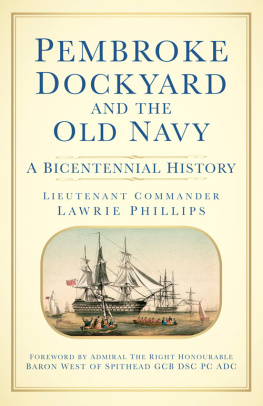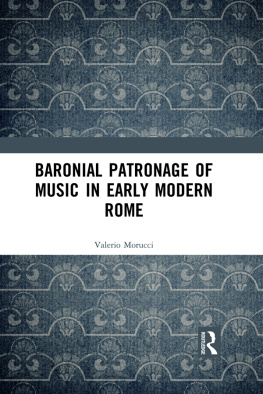Artistic and Political Patronage in Early Stuart England
Artistic and Political Patronage in Early Stuart England explores the remarkable life and career of William Herbert, Third Earl of Pembroke.
Pembroke was one of the most influential aristocrats during the reigns of Elizabeth I, James I and Charles I. He was a great patron, a prominent politician and electoral manager, an entrepreneur and a gifted poet. Yet despite his influence and many talents, Pembrokes life has been little studied by historians. Drawing on archival material, this book throws new light on Pembroke, and demonstrates just how significant he was during his lifetime.
This book will appeal to scholars and students of early modern British history, as well as those interested in politics and patronage during the sixteenth and seventeenth centuries.
Brian OFarrell is a Lecturer at U3A International, Spain. He was previously a Professor at Regents College, London.
Routledge Research in Early Modern History
The Political Discourse of the Polish-Lithuanian Commonwealth
Concepts and Ideas
Anna Grzekowiak-Krwawicz
Manila, 1645
Pedro Luengo
The Polish-Lithuanian Commonwealth
History, Memory, Legacy
Edited by Andrzej Chwalba and Krzysztof Zamorski
German Imperial Knights
Noble Misfits Between Princely Authority and the Crown, 14791648
Richard J. Ninness
The Scramble for Italy
Continuity and Change in the Italian Wars, 14941559
Idan Sherer
Artistic and Political Patronage in Early Stuart England
The Career of William Herbert, Third Earl of Pembroke, 15801630
Brian OFarrell
Bringing the People Back In
State Building from Below in the Nordic Countries ca. 15001800
Edited by Knut Dorum, Mats Hallenberg and Kimmo Katajala
Negotiating Exclusion in Early Modern England, 15501800
Edited by Naomi Pullin and Kathryn Woods
For more information about this series, please visit: https://www.routledge.com/Routledge-Research-in-Early-Modern-History/book-series/RREMH
First published 2021
by Routledge
52 Vanderbilt Avenue, New York, NY 10017
and by Routledge
2 Park Square, Milton Park, Abingdon, Oxon, OX14 4RN
Routledge is an imprint of the Taylor & Francis Group, an informa business
2021 Brian OFarrell
The right of Brian OFarrell to be identified as author of this work has been asserted by him in accordance with sections 77 and 78 of the Copyright, Designs and Patents Act 1988.
All rights reserved. No part of this book may be reprinted or reproduced or utilised in any form or by any electronic, mechanical, or other means, now known or hereafter invented, including photocopying and recording, or in any information storage or retrieval system, without permission in writing from the publishers.
Trademark notice: Product or corporate names may be trademarks or registered trademarks, and are used only for identification and explanation without intent to infringe.
Library of Congress Cataloging-in-Publication Data
A catalog record for this title has been requested
ISBN: 978-0-367-34982-0 (hbk)
ISBN: 978-0-367-34983-7 (ebk)
Typeset in Sabon
by codeMantra
To my daughters Ellen and Kathleen, without whose help and encouragement the work would never have been completed.
William Herbert, Third Earl of Pembroke, was the uomo universale of the Early Stuart period. Not only was he a prominent courtier in three reigns, but he was also a gifted minor poet, and the most important patron of the arts of the period. He was the patron of almost every important literary artist of the age. Besides this, the Third Earl was a powerful politician and the greatest electoral manager of the period. The countrys wealthiest nobleman, Pembroke was an improving landlord, a powerful industrial entrepreneur and also an indefatigable promoter of colonial enterprises.
As befitting a man who was destined to have such a profound impact on his society, his family and his connections shaped his early life. Not surprisingly, his birth as the heir to the Earldom of Pembroke was a momentous event in 1580. The record of his christening clearly shows this. In the church of St. Marys in Wilton, Wiltshire, is a marble scroll commemorating the event. It reads:
Be it remembered that at the Eight day of April 1580was born Wm, Lo Herbert, first child of the noble Henry Harbert, Erle of Pembroke by his most dere wife MaryAnd he was Xstind the twenty-eighth day of the same month in the mannour of Wilton. The Godmother ye mighty and most excellent Princis Elizabethe, by the grace of God Quene of England, by her deputye the most virtuous lady Anne Countice of Warwick, and the godfathers were the noble & famous Erle Ambrose, Earl of Warwick, and Robt Earl of Leicester, both great uncles to the infant by the mothers side, Warwick in person and Lycester by his deputye Philip Sidney, Esq, uncle by the mothers side, to the fore-mentioned young Lord Herbert of Cardiff, whom the Almighty and most Gracious God blesse with his mother above named with prosperous live in all happiness in the name of God. Amen.
The infant was the heir of Henry, Second Earl of Pembroke, and the christening party could hardly have been a more impressive one. To have the Queen as Godmother, and the Earls of Warwick and Leicester as Godfathers, says a great deal as to how important a role the Second Earl of Pembroke played in Elizabeths government, and how seriously the major aristocrats of the day considered the birth of their allys son and heir. It is also interesting that two of the greatest literary figures of the age were there as witnesses: Pembrokes mother, Mary Sidney, and her brother, Philip Sidney.
Henry, Second Earl of Pembroke, was overjoyed to be presented with a son and heir. To his friend Sir Edward Stradling, he wrote:
I thank you my good cousin for rejoicing with me for the blessing God hath bestowed upon me. Heartily wishing you the like son, knowing it would be unto you and my cousin your bedfellow a great joy and comfort, as it is to my wife and me.
It was not his connection to his mother, Mary Sidney, or her brother, Philip Sidney, however, which made the birth of the future Third Earl of Pembroke an event of such note in 1580. His proud father, Henry Herbert, Second Earl of Pembroke, was a very prominent figure in Elizabethan England. It was Henrys father, the First Earl, however, who had made the fortunes of the family. This choleric Welshman, the first Earl of Pembroke of the second creation, was the illegitimate son of the Second Earl of the first creation. Born around 1501, William Herbert quickly made his mark in Wales, and was catapulted to fame and fortune when Henry VIII became his brother-in-law. In 1543 the King married Catherine Parr, whose sister had married William Herbert. Henry VIII was lavish in his grants to his brother-in-law. In 1554 he gave him the very extensive lands of the manor of Wilton in Wiltshire, various other manors in Worcester and Cheshire and valuable lands in Glamorgan. In 1546 Baynards Castle in London was ceded to him, and this became the London home of the Earls of Pembroke until it burnt down in the Great Fire of 1666. Also in 1546, William Herbert was awarded the stewardship of several large royal properties in the west of England, and granted Cardiff castle and other large estates in both England and Wales. On Henry VIIIs death in 1547, Sir William Herbert (he had been knighted in 1543) was left 300 in the Kings will and was nominated to the Privy Council of Edward VI.








